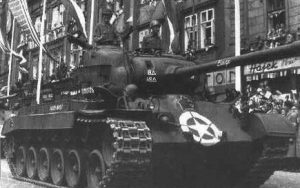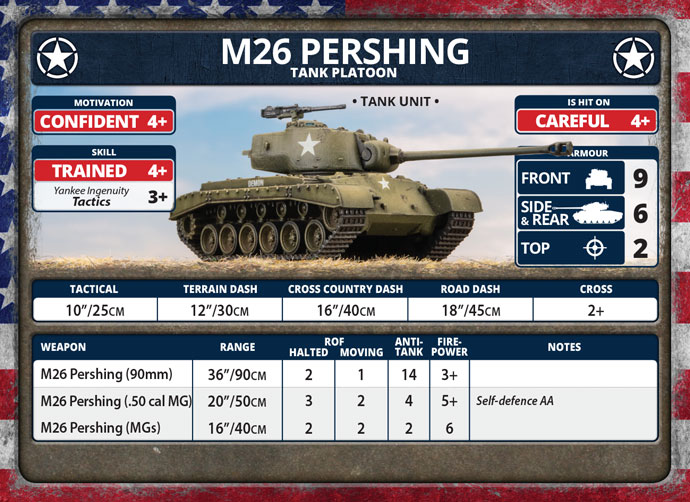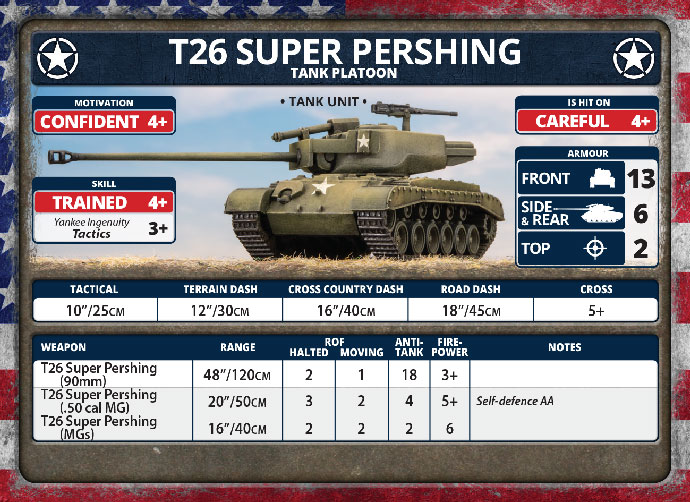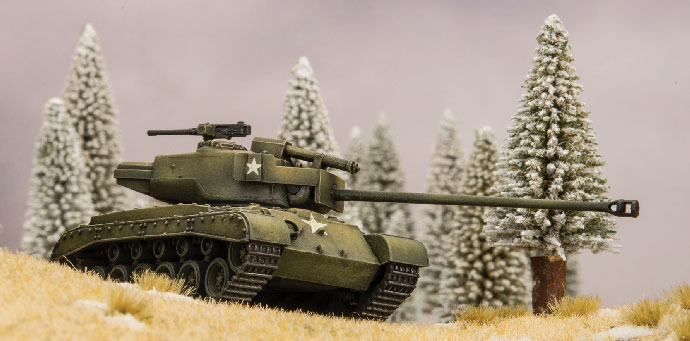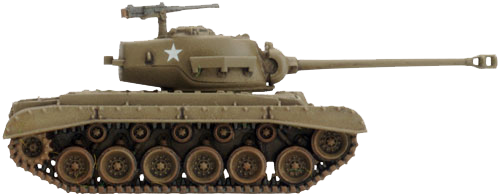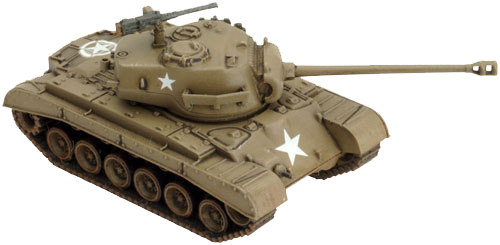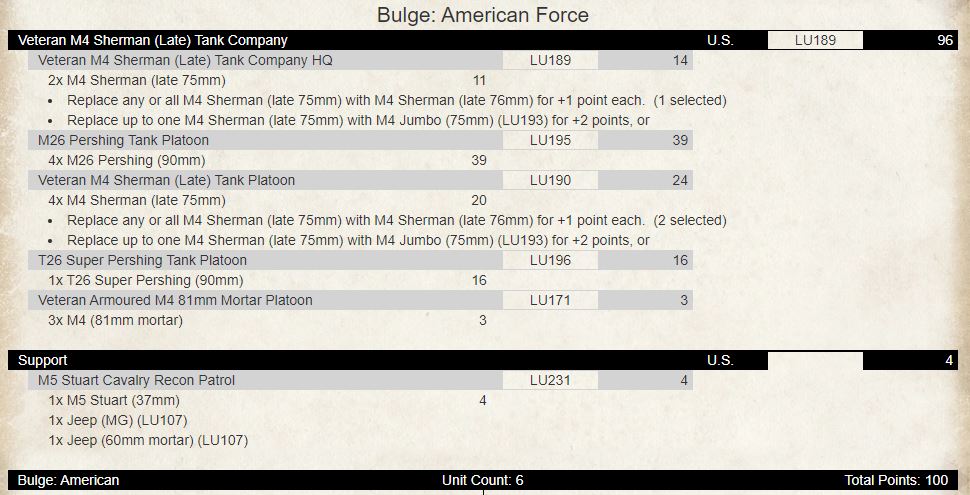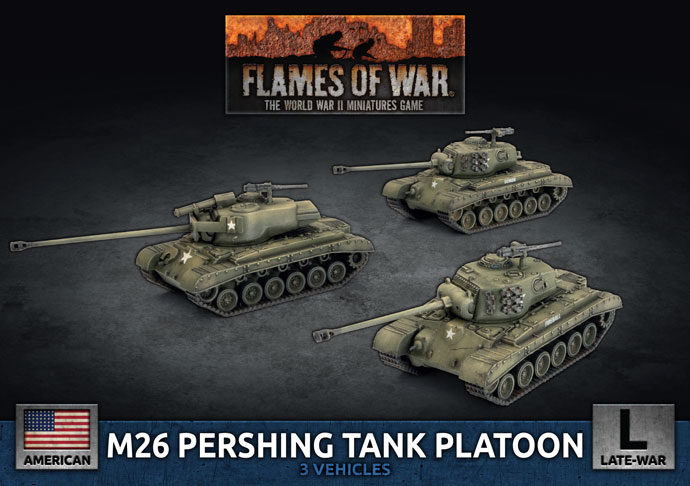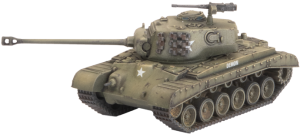
The new book Bulge: American finally sees the famous Pershing tank. Since 1943 the Germans have demonstrated their superiority in armoured vehicles but with the arrival of this tank this is finally being questioned. I think everyone is just as excited as I am, so let’s go see the features of this end-of-war tank.
History
The United States could count on an excellent medium tank already a few months after entering the war. The M4 Sherman, in fact, entered service as early as 1942 and participated in the war effort giving excellent proof of itself. With the Tiger’s entry into service in 1943, however, the Sherman quickly showed its limits in dealing with this heavy tank. On the other hand, the construction of a heavier tank than the Sherman had already been under consideration since 1940 but the project suffered numerous slowdowns. From T6 the project evolved into T20 in May 1943 and then changed again to T23. But the continued superiority of the Tiger pushed the leaders to further evolve the project and equip the tank with a powerful 90mm cannon that was able to easily pierce the opponent’s armour.
The T26E3, as it was called at that time, went into production from November 1944 and 242 units were made until February 1945. From model 197 onwards, the tank was renamed M26 Medium Tank “Pershing”, by the US general John Pershing commander of the ‘American Expeditionary Forces. 6,000 units of the tank were then authorized, but only 1436 units were made.
The Ardennes offensive revealed the supremacy of German armored vehicles in a condition of lack of air superiority. It was for this reason that the High Command quickly decided to send the first pre-series M26 Pershing to the continent. Arriving in Antwerp shortly before Christmas 1944, they were then distributed to the departments in January: ten were assigned to the 32nd and 33rd tank regiments, while another ten armed two companies of the 9th Armored Division. Towards the middle of February the departments completed the training to be then already engaged at the end of the same month at the Roer river (Operation Veritable). Before the VE (Victory in Europe) as many as 200 M26 Pershing operated on the European battlefields but the tank had no way to operate in the Pacific as the war ended earlier. On the other hand, the M26 Pershing was used later in the Korean War and ended its career in 1953.
Profile
The Pershing tank looks like a hybrid between the tiger and the panther. Its frontal armour is equal to 9, the same value as the Tigers and Panthers. Such a high value makes it completely invulnerable to light cannons and practically invulnerable to medium ones. Only high-velocity guns like the Pak40 or Zis2 have any hope of being able to pierce its armour (and only at short range). The main threats are heavy tank destroyer guns such as 88mm, 100mm or 17pdr. Against these guns you have to be very careful but fortunately they are not particularly fast guns.
The medium tanks do not have much hope of facing the Pershing head-on and coming out victorious. Other heavy tanks on the other hand, are more dangerous but the Pershing is also a match for them: a perfect balance! The side armour on the other hand does not offer as much protection. With a value of 6, even medium tanks can be particularly dangerous. It is therefore necessary to manoeuvre carefully to avoid being bypassed, even by tanks such as the Panzer IV or the T-34. As you may have guessed assaulting will not be so easy. Panzerfausts, Parzerschrecks, PIATs and bazookas can be very dangerous and could push you back from an assault if not eliminated or in any case if the unit has not been pinned. On the other hand, the Pershing has a top armour of 2 which makes it an unsurpassed opponent for those infantry units that have not taken anti-tank support or perhaps have lost it. In addition, this top armour provides good protection against aircraft which can be very dangerous. Overall, the protection of the Pershing is quite adequate even if it is nothing exceptional when compared to other similar tanks.
The Pershing moves like medium tank with a Tactical value equal to 10. It also manages to adequately exploit the terrain while not being particularly effective in crossing them. Thanks to a Cross Country Dash of 16 ” it can dart to hide behind terrain quite easily. On the other hand, it is more difficult to cross the terrain due to a 12 ” Terrain Dash. Entering the terrain risks slowing down a lot but the Pershing has an excellent Cross value of 2+ which allows it to cross the terrain with ease even while moving at tactical and firing at enemy tanks. The Road Dash is rarely used but in case you are lucky enough to skid on a road you could move up to 18 “.
The armament is a source of pride for the Pershing tank with it mounting an excellent 90mm long gun that can hit targets at 36 ” away. This value is lower than that of German guns of the same size but it is perfectly serviceable for our needs. The anti-tank value is very high with it equaling other heavy tanks at 14 and can therefore penetrate almost heavy tanks in the game. Tigers, Panthers, Churchills and IS-2s must all therefore be very careful. Only the Ferdinand and the Elefant are completely immune, but they are immune to everything that comes from their front! The firepower is also comparable with 3+. Once they fail an armour save you will destroy two out of three tanks. The Rate of Fire is equally adequate with 2 when the Pershing is halted and 1 when the Pershing is moving. Unfortunately the Pershing can’t rely on Stabilizer that American players are used to and the Pershing must therefore be played in a different way from the Sherman. The Pershing also has a lot of light firepower to handle infantry and guns and is equipped with a powerful .50 “and two .30” lighter. They can then fire 4 shots while moving and 5 shots from stationary. Infantry will not be able to assault a Pershing Platoon and can very easily threaten to pin an assault. The .50 “machine gun can also fire anti-aircraft fire (self-defence), giving the Pershing some protection against planes that would undermine its Top 2.
The training of the Pershing is adequate. Getting hit at 4+ is quite useful when you can count on 9 armour but not definitive against the guns that populate the Late War battlefields. Using any cover, the Pershing will be hit at 5+ which is not easy to hit. The motivation is average with Confident 4. Keep in mind that very often the HQ will be needed to reroll important morale rolls. Their training is also average Trained 4+. However, as with American veteran tanks, the Pershing can count on Tactics 3+ giving them a skill rating that can be really decisive for such powerful tanks. The Pershing must rely on it and exploit it and as you may have guessed, the Pershing cannot be a cheap tank and costs just under ten points with even the smallest platoon costing 19 points for just two.
The Super Pershing
If you think the Pershing isn’t armoured enough or powerful enough, well then you should aim for the Super Pershing!
In 1945 the Germans began to deploy the very powerful Tiger II Konig Tigers making the Pershing far less effective. It was decided to up-gun the M26 by installing a more powerful 90 mm cannon with the T15E1 gun, the American answer to the 8.8cm KwK43 that can penetrate 330mm of armour. This vehicle was based on the first T26E1 vehicle and after trials a single tank was then shipped to Europe and attached to the 3rd Armored Division. The men of the 3rd Armored Division’s maintenance workshops further modified the tank by cutting out armour plates from German Panther tanks and welding them to it, creating the unique T26E1-1 ‘Super Pershing’.
As you can imagine the Super Pershing has a lot in common with Pershing. Basically the main changes concern the frontal armour and armament. The armour of the Panther welded on the front brings the Front Armor to 13, making it practically invulnerable to the blows of almost any weapon that plies the battlefield. Only the most heavily armed tanks like the Jagdpanther and the Elefant are truly a threat to a Super Pershing. Tiger, Panther and M10 instead have a very limited effectiveness, being able only to hope to bail the American heavy tank. On the other hand, the side armour remains at 6, leaving the Super Pershing particularly vulnerable during assaults on weapons such as bazooka, panzerfaust and PIAT. As for the armament, the 73-caliber 90mm cannon can hit targets within 48 “and pierce almost anything thanks to an anti-tank value of 18. Virtually any tank can be penetrated from the front. Even the Elefant can be destroyed at short range, It is a deadly weapon but with so few shots per game it should only be aimed at strongest targets.
The training of the Super Pershing of course is the same as that of the regular Pershing since the tankers are from the same division. The platoon is made up of only one specimen since the Super Pershing was built in only one specimen. Of course the point cost represents these very important values of armour and armament, a Super Pershing costs more twice that of a M26 Pershing but it’s worth all the investment. Let’s see why together.
On the battlefield, Super Pershing’s role should be the pillar on which to build the game. Formations of tanks very often find themselves facing some units that are difficult to deal with. Maybe a heavy anti-tank gun unit, a heavy tank destroyer like the Elefant or maybe a tank destroyer unit. The Super Pershing can confront them head-on, standing in the middle of their line of fire, and shoot them in turn with high hopes of destroying the target. Of course it is a piece that must be moved with great caution as it must avoid being flanked at all costs. Apart from that give it a try and you will have fun as it the weight and hitting power of this tank becomes the centre of gravity of your tank company.
A comparison between heavies
The Pershing is rightly designated as the American heavy tank. The Americans are undoubtedly the last of the major powers to develop this type of tank so now let’s now make a comparison to better frame it among the heavy tanks of the Late War.
Pershing vs Tiger
The Tiger is undoubtedly the most famous tank of the Second World War. When it entered service in 1943 it radically changed armoured warfare. Thanks to powerful armour and a powerful cannon it proved to be a near undefeatable vehicle for many tanks of the Allies for the initial time in which it was first introduced. With the M26 Pershing, the Tiger shares a very good frontal armour of 9 making it nearly unassailable for medium tanks and less powerful anti-tank guns. Both of these tanks can then move forward with relative peace of mind as long as they are concerned about avoiding heavy anti-tank guns or more powerful tanks. M26 Pershing and Super Pershing also share a top armour of 2 making them virtually unassailable for infantry lacking anti-tank weapons such as bazooka or Panzerschreck / Panzerfaust. The big difference is undoubtedly the side armour. The Tiger can count a Side Armor of 8 which makes it a particularly hard nut to crack even for portable anti-tank weapons and cannons that carry out defensive fire the Pershing has a value of only 6. It therefore follows that while the Tiger can assaulting almost all infantry with relative tranquillity the Pershing must be much more careful to limit the blows it will receive as much as possible. Flanking must also be taken into account. The Tiger can practically ignore the medium and light tanks attempting to flank it such as the Panzer IVs, T-34s and Shermans with 75mm guns. The Pershing does not have this advantage and must manoeuvre carefully to avoid nasty surprises. Surprisingly, the Tiger can count on greater mobility as the powerful engine compensates for the increased weight. The difference is not on the Tactical movement which is equal to 10 for both tanks, but on the Cross Country Dash. The Tiger can move 18 “while the Pershing” only “16”. It’s not a big difference, but sometimes two inches can make the difference between a good position and a dangerous position. Even with regard to the Road Dash, the Tiger can count on these fateful 2 extra inches. The terrain mobility in Dash is exactly the same with 12 “and cross at 2+. As for the armament, the Tiger and Pershing are equipped with a gun with the same characteristics of Rate of Fire, Anti-tank and Firepower. The only difference lies in range. the Tiger’s cannon can hit (and destroy!) targets at 40 “while the Pershing’s at 36”. This can undoubtedly be a more important difference because 36 “is the range of many allied anti-tank weapons. The tiger can then strike without being hit, while the Pershing will have to manoeuvre to avoid return fire.
The Pershing however has better anti-infantry armament. While the Tiger has only two machine guns for a total of 4 rounds (both moving and stationary) the Pershing has two .30 “machine guns and one .50” machine gun for a total of 5 stationary rounds and 4 moving rounds. Of these two or three shots (depending on whether the tank is moving or not) have an anti-tank of 4 and a firepower of 5. In addition, the .50 “can fire anti-aircraft.
Both the Tiger and Pershing are 4+ to be hit, dodging 50% of hits even in open field. Both have a Motivation of 4+, but because the Tiger-equipped units were assigned to the best tank crews, they have a Remount and a Last Stand of 2+. This makes the Tigers a much tougher bone, which must always be taken into consideration.
On the battlefield Tiger and Pershing play different roles. The Tiger is a complete tank that can engage opposing heavy tanks and subsequently assault opposing infantry. The Pershing on the other hand tends to limit itself to engaging enemy tanks, perhaps attacking them on the side so as not to avoid being flanked in turn.
Pershing vs Panther
The Pershing is known on the playing field as the American Panther, it is no coincidence that these two tanks have many traits in common. The front Armor is identical with a value of 9 which offers decent protection. The side armour is also very similar, although slightly in favour of the Pershing. The Panther can only count on a value of 5 while the American tank of 6. It is certainly not a substantial difference but sometimes that point can make a difference: I have seen Panthers destroyed by armoured cars or light tanks with an anti-tank of 7 take advantage of too many 1 rolled on protection throws. With a value of 6 the greatest risk is to be bailed, a big difference. Most significant is the difference on the Top Armor. In spite of the excellent front armour and the powerful gun, the Panther has a Top Armor of 1 like that of the lighter tanks (the M3 Stuart for example!). This does not make Panther suitable for assaulting enemy infantry, especially considering the side armour . The Pershing on the other hand has a Top Armor of 2, which gives the American tank the option of assaulting infantry who have do not have their anti-tank weapons or have lost them due to casualties.
The Panther has greater mobility than the Pershing. On both the Terrain Dash and the Cross Country Dash another 2 “must be added for a total of 14” and 20 “. Detroit’s finest is not up to par with the German engines, at least for the moment. Even greater is the difference on the Road Dash (24” for the Panther) which can have a marginal importance. Thanks to these better characteristics, the Panther is able to make better use of cover and if necessary cross larger distances while in terrain compared to the Pershing.
The gun of the Panther is the same in terms of effectiveness as that of the Tiger so the same considerations already made previously apply.
In terms of training, more or less the same goes except that the Panther cannot count on a crew as motivated as that of the Tigers. The German Third Reich national rule guarantees him a Last Stand of 3+ making them more likely to remount compared to the Pershing.
On the battlefield Panther and Pershing behave in similar ways, using their powerful cannon and excellent frontal armour to take on medium and heavy tanks. The biggest difference is that Pershing can have that extra edge to end the game by assaulting the enemy infantry that holds the objective firmly.
Pershing vs IS-2
The American and Soviet heavies have very little in common. The IS series tanks, either IS-2 or IS-85, are tanks conceived as armoured giants designed to face German heavy tanks but above all assault infantry bristling with Panzerfaust and Panzerschreck anti-tank weapons. The armour of the IS tanks is in practically every respect superior to that of the Pershing. While the latter can count on a value of 9, the IS tanks have a value of 10. A point of difference may seem small but it is not so when facing anti-tank values of 12 (to which they are nearly invulnerable) or of 14. The side armour of the IS is also superior with a value of 8 and is a real challenge for medium tanks and light anti-tank weapons . The top armour on the other hand is the same making it resistant to aircraft and infantry. Despite the greater armour the IS can count on a fast movement thanks to their superior engine.
As for the armament, the situation is quite varied. The IS-2 has a powerful cannon designed primarily to flush out infantry. At 122mm it does not have a particularly high piercing capacity, it is the same as that of the Pershing, but it has a better firepower of 2+ and the Brutal rule that forces infantry and non-armoured vehicles to re-roll successful saving throws. On the other hand due to the particularly complex ammunition the rate of fire is 1 both when the tank is stationary and when the tank is in motion. The cannon also has the slow firing rule which adds +1 to the roll required to hit the enemy when the tank is moving meaning if it moves it will have a harder time hitting its target.
The gun of the IS-85, on the other hand is lower in terms of performance to that of the Pershing. The rate of fire is identical to that of the Pershing tank but the anti-tank value is equal to only 12 which is 2 points lower than that of the Pershing. This means that the IS-85 struggles to take on all heavy tanks but excelling against medium tanks. The firepower is equal to 3+, which seems appropriate for 85mm guns. The anti-infantry armament of the Pershing is superior to that of the counterpart thanks to the second light machine gun of the Pershing allowing more overall shots when stationary.
As for training the IS like almost all Soviet tanks, are 3+ hit because they are aggressive. This means they will have to take a lot more hits. Their morale on paper is the same (confident 4+), but the No one step back rule gives the Soviet tanks a Last Stand of 3+. While the strong anti-infantry vocation this gives it a Counterattack value of 3+.
On the battlefield, the IS and the Pershing play completely different roles. The Pershing takes on enemy tanks from a distance while the IS are at their best in assaulting the infantry head-on.
Pershing vs Churchill
Her Britannic Majesty’s army does not have (at least for the moment) any tanks similar to the Pershing. Until further development (which there will be, and how if there will be!), The only heavy tank deployed is the Churchill. Born as an evolution of the mythical Matilda it is a support tank for infantry designed to give a hand during assaults. It is therefore not surprising that the mobility of the Churchill is indeed lower than that of the Pershing. The British tank can only move 8″ per tactical which is the same speed as the infantry. Also for the Dash the speeds are lower: 10″ on the ground, 14″ in the open field as well as on the road. At least the value of Cross is the same: 2+. Concerning the armour it is necessary to distinguish between the different variants of the Churchill present on D-Day: British. The Churchill armed with a 6pdr cannon has an armour of 9 (identical to that of the Pershing) while the Churchill armed with the 75mm cannon, it has an armour value of 11. A similar value is really considerable, excellent for dealing with even high anti-tanks. The side armour is for both Churchill models equal to 8, identical to that of other heavy tanks and great for assaulting infantry. The top armour is the same.
The Pershing has a much more effective on armament. The 6pdr has an anti-tank value of just 11 with a firepower of 4+ while the 75mm has a value of 10 with a firepower of 3+. In addition, the range of the British tank is just 28 “. It is therefore not surprising that in a Churchill vs Pershing battle, the Churchill has very little chance as it is not suitable for dealing with heavy tanks in a head to head fight
Pershing and Super Pershing In their formation
Given the few Pershing that entered service during the Ardennes Offensive, it is not surprising that these tanks are available in limited numbers. The Pershing’s platoon is available as for one of the slots of the Veteran M4 Sherman (late) Tank Company formation. At least this slot is one of the two Compulsories so any American formation can field a Pershing platoon as Support.
Pershing’s platoon consists of two to five tanks. Considering the cost of tank it will be necessary to decide whether the Pershing will play the leading role and investing a good number of points in this unit, or relegate this powerful tank to a support role. The possibilities are many, what is your solution?
Finally we must also talk about the Super Pershing. The platoon consists of only one tank and the slot, unlike that of the common Pershing, is not a compulsory. To deploy this powerful vehicle you will have to play a tank formation: you will not be able to be smart!
This list is a classic example of a list built around the new US Army tanks. Overall, it ranks 4 M26 Pershing and 1 T26 Super Pershing making for a real armoured mass. The unit of M26 Pershing has a very appropriate cost because it can be left in reserve if necessary (some missions also require the attacker to have 40% of the points left over) and occupies almost all the points reserved for it. You can also leave the recce in reserve, a necessary sacrifice. The Super Pershing will certainly be on the table and this should give the American player a advantage. The Sherman platoon is a particularly useful unit. It has the well armoured Jumbos capable of absorbing the most powerful enemy shots by using the mistaken target rule along with two tanks capable of hitting enemy tanks back along with a Sherman (late 75mm) capable of effectively hitting infantry or firing bullets or smoke bombs. The Jumbo also has a 75mm gun effectively adding to the effectiveness of the unit here too.
Unfortunately, the high cost of the units did not allow for powerful artillery support. The mortars can provide the necessary smoke to allow the tanks to assault which is a must have for the points this unit costs.
As you can see, this other list is more balanced than the previous one. By giving up an M26 Pershing and the mighty Super Pershing enough points are spare to insert a substantial amount of infantry support and artillery. The infantry should be able to capture or defend targets that tanks struggle to cope with. Personally I think that all balanced lists should have at least one infantry unit. The armoured rifle platoon is particularly effective as it is equipped with five bazookas, two light machine guns and a mortar, not to mention the armoured half-tracks which are excellent for moving around the battlefield. The priests, on the other hand, are an excellent artillery for their points. Equipped with excellent anti-tank and firepower when bombarding they can be particularly lethal, especially with the Time on Target rule. In addition they can fire smoke both as direct fire and when bombarding. All for just 8 points. The unit is made up of only 3 guns but being armoured vehicles should help them survive. Sometimes hiding them can be a very good solution which is why I put in an aerial observer. Bombing from inside a forest or behind a building may seem obnoxious but is very effective. The basis of this list has remained is more than capable of meeting almost any challenge on the battlefield.
So what are you waiting for? Be sure to try the M26 Pershing and see what they can do on the battlefield with the American answer to the German Panther!

